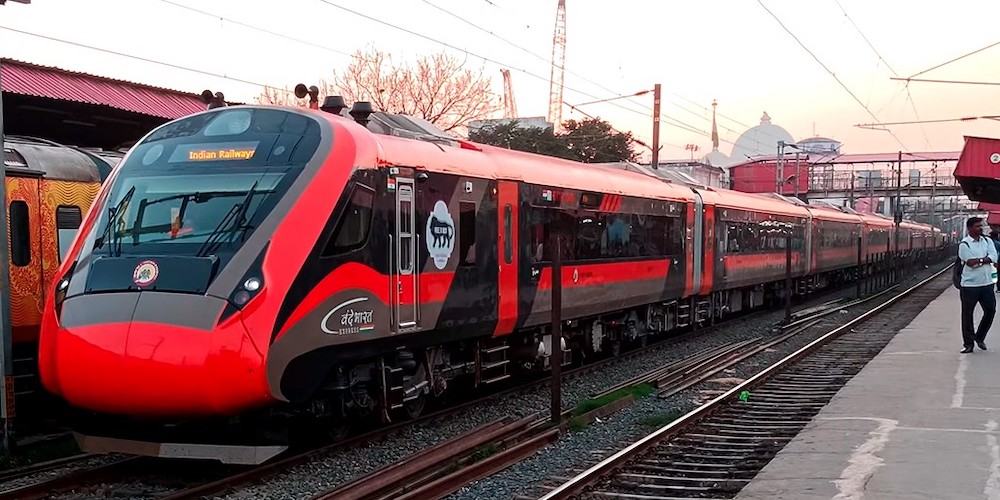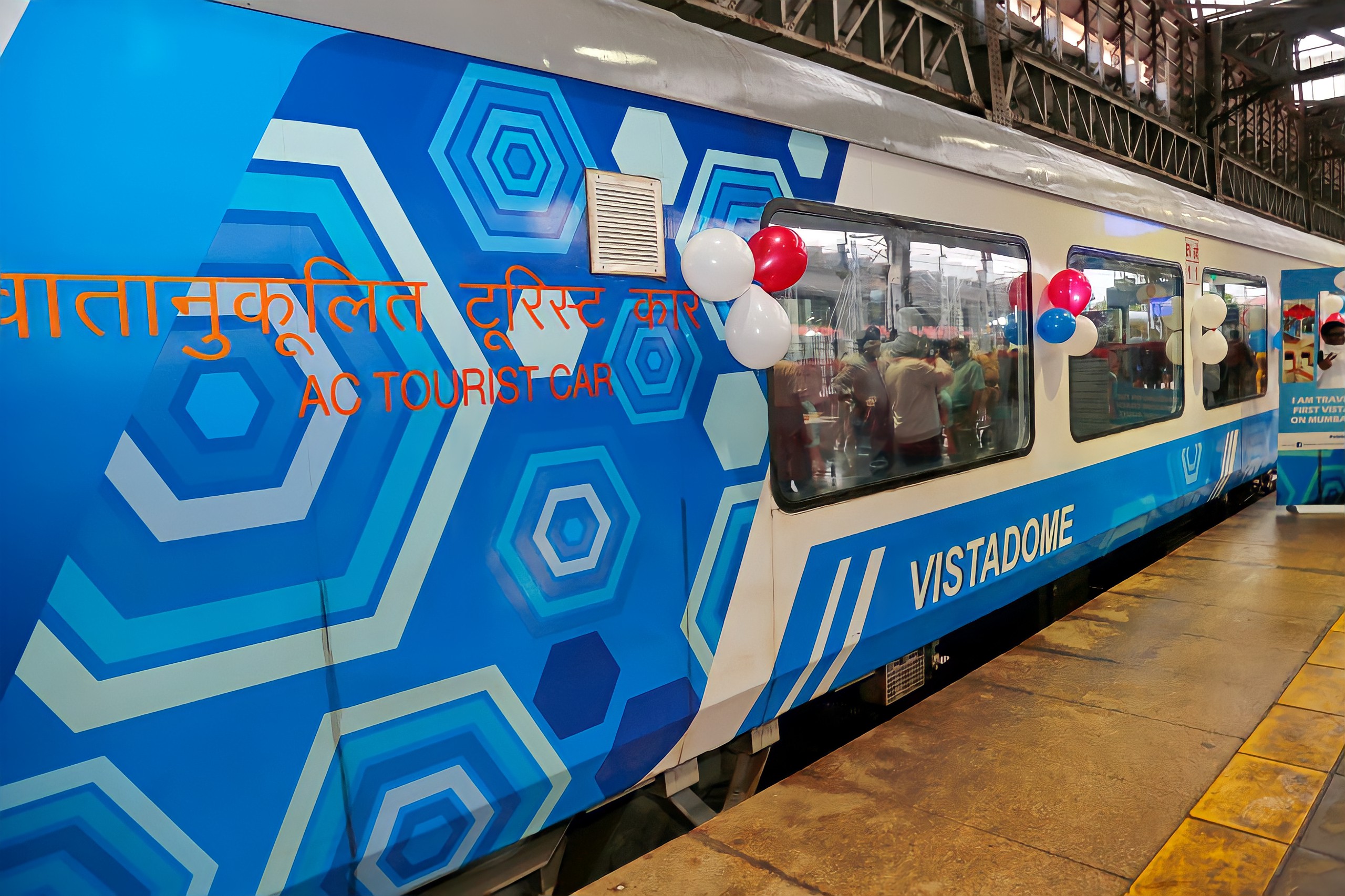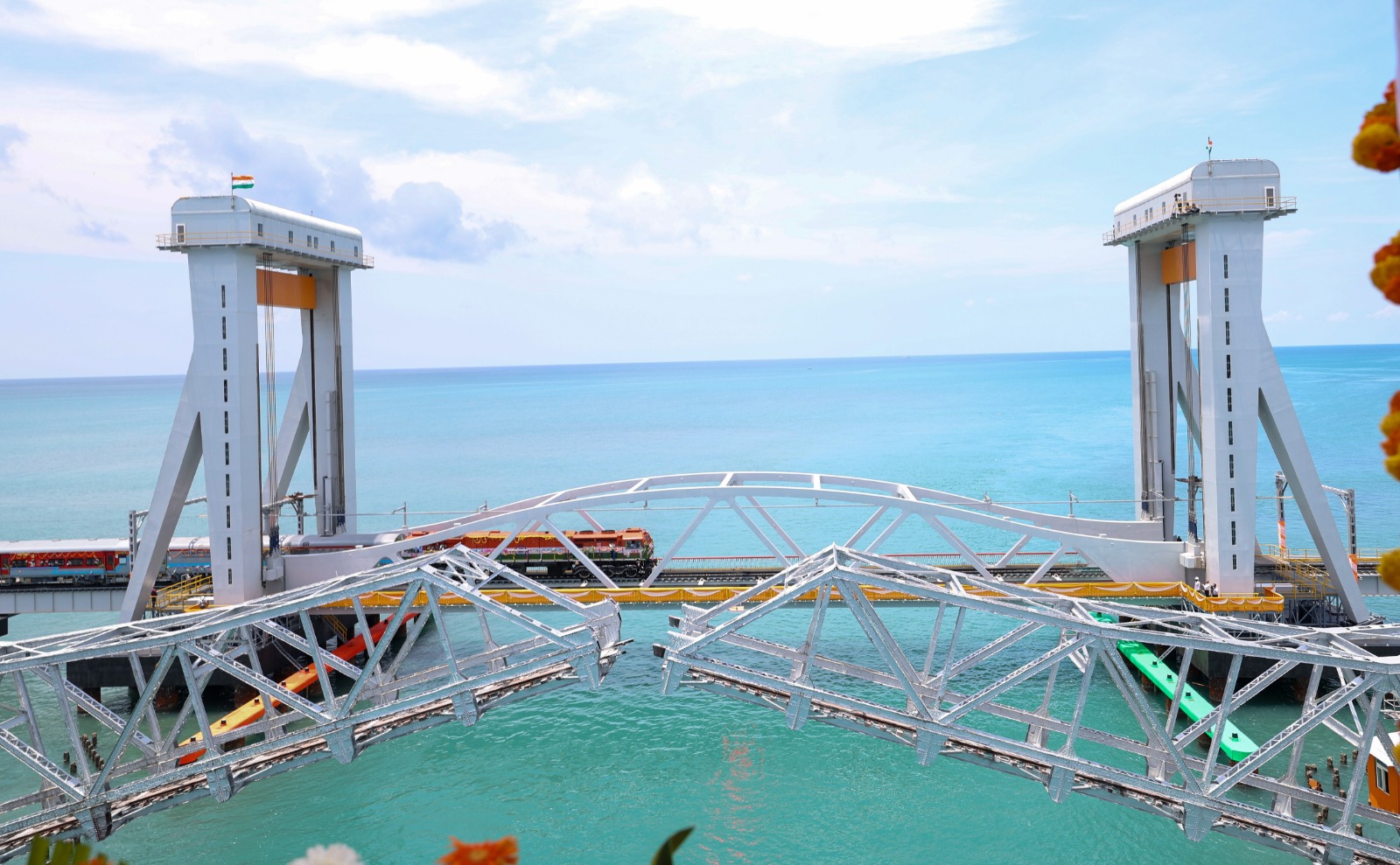11 years of Modi government: Indian Railways is reaching new heights

While the train to Kashmir is one of the dreams fulfilled, the Indian Railways is now on an ambitious journey to connect each and every corner of the country, including remote places in the northeastern region of the nation by electrified broad-gauge rail tracks. An exclusive report.
On June 6, 2025, history was made in the Kashmir valley as a pair of Vande Bharat semi-highspeed trains were flagged between Shri Mata Vaishno Devi Katra terminal and Srinagar by Prime Minister Narendra Modi. This landmark event led to the official culmination of the 324km-long Udhampur-Srinagar-Baramulla Rail Link (USBRL) project which had been lingering since decades. The BJP-led NDA government finally fulfilled the dream of 146 crore Indians of having an all-weather rail link to Kashmir from the mainland, which has now proved to be a final nail in the coffin for separatists and terrorists. This brand-new rail link was awaited since more than the last 100 years which will not only lead to an influx of tourists into Kashmir, but will also facilitate brisk trade between the valley and rest of the country, with spices, apples and cherries poised to swiftly reach all regions of India via goods trains. The railway tracks pass through astounding modern engineering marvels like the Chenab bridge, Anji Khad bridge and Banihal-Qazigund tunnel (Pir Panjal railway tunnel) which stand as breathtaking spectacular monuments of a new India never envisaged before in South Asia.
But the USBRL project is like a small needle in the haystack as a plethora of other ambitious railway projects are also coming up in the country. While some of these projects have been taken to fruition by the incumbent union government after decades of inaction by the previous Congress-led central governments, others are on the verge of being realised well on time over the next three to four years with adequate budgetary support and the right political will and intent.

Prime Minister Narendra Modi inaugurating the Chenab rail bridge on June 6, 2025
Rail connectivity in Northeast
With the union government asserting upon providing rail connectivity to the entire northeast, Indian Railways has accelerated the civil works connecting state capitals of Assam, Arunachal Pradesh and Tripura. The states have already been connected by a broad-gauge track network. The government has undertaken a major exercise to connect all state capitals of northeast (barring Meghalaya) by 2029.
Sikkim and North Bengal: The icing on the cake is that in Sikkim, work is ongoing on a new railway line from Sivok in North Bengal up to Rangpo in Sikkim in the first phase, which will be further extended to Gangtok in the second phase. The 45km-long Sivok-Rangpo stretch will pass through the Darjeeling, Kurseong and Kalimpong forest divisions and through the famous Mahananda Wildlife Sanctuary. The track will have a total of 28 bridges and 14 tunnels and is being rapidly constructed though the foothills of Kangchenjunga Mountain Range and Teesta River Valley. There are further plans to extend the railway tracks from Rangpo all the way up to the India-China border crossing at Nathu La pass via Gangtok. Hence, it is a project of national importance which is being directly monitored by the Prime Minister’s Office (PMO).
Since rail connectivity also plays a very pivotal role in the development process, railways have taken up several projects in the north-eastern region and allocated a higher budget in the last five years for this purpose. According to Indian railways’ data, the national transporter has taken up 20 (14 new lines and six track doubling) projects of a total length of 1,786 km, costing Rs. 73,214 crores in the northeast region alone, which are in different stages of planning, sanction and execution. For the region, the average allotment per year for infrastructure and safety projects was Rs 2,122 crore per year from 2009-14. However, it was increased by 161 percent to Rs 5,531 crore per year during 2014-19.
As a mission, the capital city of ‘seven sisters’ including Arunachal Pradesh, Tripura, Manipur, Mizoram, Nagaland, Meghalaya, Sikkim as well as Assam are to be connected with the national network of Indian Railways. Out of these eight states, the capital cities of Assam, Arunachal Pradesh and Tripura are already connected with mainline network and work is in progress on the remaining five states.
Arunachal Pradesh: In Arunachal Pradesh, a broad-gauge line was commissioned in February, 2015 up to Naharlagun (near Itanagar) and first train on the route was flagged off by Prime Minister Narendra Modi on February 20, 2015, from Naharlagun (Itanagar) to New Delhi. In Tripura, the first long-distance train running between Agartala and Delhi was introduced on July 31, 2016.
Works of new broad-gauge lines have now been taken up to connect the remaining capitals of north-eastern states- Meghalaya (Shillong), Manipur (Imphal), Nagaland (Kohima), Mizoram (Aizawl) and Sikkim (Gangtok). Most of these projects are being undertaken in extremely difficult terrain and at some places the progress of new line projects has been adversely affected due to delay in land acquisition along with law-and-order issues. All these connectivity projects being in the hilly terrain of Himalayas, involve a large number of tunnels and major bridges including very tall bridges in a very challenging geological environment.
Manipur: Jiribam, the first railway station in Manipur was connected by broad-gauge line and the first freight train was received on February 20, 2016. The first passenger service to Jiribam was inaugurated by Prime Minister Narendra Modi by remote control from Shillong on May 27, 2016. The project of broad-gauge line connectivity from Jiribam to Imphal (110.62 km) in the state was sanctioned in 2003-04. The latest anticipated cost of the project is Rs 12,524 crore. The section from Jiribam to Vangaichungpao (12 km) was commissioned in March, 2017 and work from Vangaichungpao-Tupul- Imphal (98.62 km) has been taken up. This project is likely to be completed by the end of 2028.
Mizoram: Bhairabi, the first railway station in Mizoram was connected by broad-gauge rail tracks and the first freight train was received on March 21, 2016. The first passenger train service to Bhairabi was also flagged off by Prime Minister Narendra Modi by remote control from Shillong in May, 2016. The project of connectivity from Bhairabi to Sairang (51.38 km) was sanctioned in 2008-09. The anticipated cost of the project is Rs 5,021 crore, and the land could only be made available in 2014-15 and work speeded up from 2015-16. The construction work has been taken up throughout the length of the project and 80 percent tunnelling work has been completed and the work on six tall bridges has been taken up. This project is likely to be completed over the next one year.
Nagaland: In Nagaland, the project of railway connection from Dimapur (Dhansiri) to Zubza (Kohima) (82.50 km in length) was sanctioned in 2006-07. The latest anticipated cost of the project is Rs 3000 crore and the work was speeded up after September, 2018. The construction work has been taken up throughout the length of the project. This project is likely to be taken to its logical conclusion in the next two years.

Meghalaya: In Meghalaya, two projects of the broad-gauge lines have been taken up for capital connectivity. A new line from Tetelia to Byrnihat (21.50 km) was sanctioned in 2006-07. The latest anticipated cost of the project is Rs 1,532 crore and the work has been speeded up from 2014-15, 10 km length of the project falling in Assam from Tetelia to Kamalajari got completed in October 2018. A new route from Byrnihat to Shillong (108.40 km) was sanctioned in 2010-11. The latest anticipated cost of the project is Rs 6000 crore. Some regionalist and separatist organisations have stated that railway connectivity may lead to an influx of outsiders and this has led to some local resistance to this project. But the issue is now being sorted out by discussing the same with all stakeholders. The target dates for completion of Tetelia-Byrnihat and Byrnihat to Shillong routes have not yet been fixed, as the same would be decided once the complete land is physically handed over to the Indian Railways and the nitty-gritties of the proposed ILP (Inner Line Permit) related issues are sorted out.
Towards realising the mission to provide broad-gauge connectivity to capital cities of all north-eastern states, the old metre gauge track to Agartala was also converted into broad-gauge on May 2, 2016.
Assam: A huge national project of strategic importance- the Bogibeel rail-cum-road bridge, was completed and commissioned by Prime Minister Narendra Modi on December 25, 2018. By commissioning of this 4.94 km-long giant structure over the Brahmaputra River, travel time between Naharlagun and Dibrugarh has been reduced from 24 hours to just five hours. Alongside, Lumding-Hojai track doubling works (44.92 km) have been completed and commissioned and opened for traffic in July, 2019.
Tripura: The completion, commissioning and opening of Agartala-Sabroom new line (112 km) was witnessed in October 2019. The first train on Lumding-Silchar newly converted broad-gauge section was earlier flagged off on November 21, 2015. Barak Valley of Assam is now fully connected to major cities of the country through railways.
The upcoming train to Leh
Bhanupli-Leh line is another high-elevation all-weather broad-gauge railway route that is planned to connect Bhanupli in Punjab via Bilaspur in Himachal Pradesh to Leh in Ladakh. The total expected length of this line is 552.1 km and it would become the highest railway track in the world (overtaking the current record of the Qinghai–Tibet Railway of China) once the project is completed. After the USBRL line in Kashmir, the Bilaspur–Leh stretch of Bhanupli-Leh route will be the most challenging project in the history of Indian Railways due to high mountains, a large number of tunnels, high bridges and severe cold weather conditions. The Northern Railways is in the process of acquiring land for setting up a camp office in Leh for overseeing the ambitious project. Once this line is completed, Leh will be directly connected to Himachal Pradesh and the rest of India by electrified broad-gauge rail.
Long pending projects
Trains though Nashipur bridge: The long awaited Nashipur rail bridge built on Bhagirathi River in West Bengal’s Murshidabad district was inaugurated by Prime Minister Narendra Modi on March 2, 2024. Due to absolute inaction by the erstwhile left-ruled state government, and the incumbent TMC-led state government of Mamata Banerjee, land acquisition for laying the railway tracks to the bridge was delayed for almost 15 years. The stalemate was broken by the Modi government, and now, the bridge- fully operational, reduces the distance between Sealdah (Kolkata) and New Jalpaiguri (Siliguri) by almost 20km. The much-awaited long distance train (13115/13116 Sealdah-Jalpaiguri Road-Sealdah Humsafar Express) was inaugurated to ply through the Nashipur bridge route on June 14, 2025 with commercial passenger services beginning from June 20, 2025. With this, the people of the region got their lifetime gift of having railway connectivity with the rest of India. The logical next step now lies in starting more MEMU and long-distance mail or express trains through this bridge.
Rail connectivity in Chhattisgarh: The state of Chhattisgarh has a population of more than three crore people and a total land area of 1,35,194 square kilometres. But despite of its sheer large size, the state severely lags behind in railway connectivity with just 1313 RKM (route kilometres) of broad-gauge rail tracks as of May 31, 2025. The town of Khairagarh in Chhattisgarh boasts of having Asia’s first ever music and art university (Indira Kala Sangit Vishwavidyalaya) which attracts thousands of students from India and across the globe every year. But it is a matter of concern that the town still lacks rail connections even after 78 years of independence. Work on the proposed 615km-long Khairagarh-Parmalkasa new line which will pass through Bilaspur and Raipur bypass is yet to be started. Moreover, the much-awaited 277km-long Dongargarh-Katghora rail line via Khairagarh and Kawardha, is yet to see the light of the day. Now that Chief Minister Vishnu Deo Sai-led BJP-ruled state government is in power in Chhattisgarh, the union government must give full thrust to all pending projects in the region with prompt preparations of project reports and requisite full-fledged budgetary support without any further dithering.
More Vistadome tourist trains required

A Vistadome Coach attached with Deccan Queen
The Indian Railways has been quite innovative in its approach towards attracting tourists by introducing Vistadome coaches with large windows and glass roofs for a clearer view of the picturesque surroundings. While the narrow-gauge Darjeeling Himalayan Railway (DHR) in West Bengal and Kalka-Shimla Railway in Himachal Pradesh have special Vistadome coaches, the Nilgiri Mountain Railway in Tamil Nadu is yet to witness such facilities for tourists. Broad-gauge tourist special trains like with Vistadome coaches plying on the NJP-Alipurduar route in North Bengal and Guwahati-Badarpur route in Assam are doing quite well. It is also time to extend the services of the Vistadome train currently plying between Budgam and Banihal in Kashmir up to Shri Mata Vaishno Devi Katra and then further down to Jammu. With increasing traffic volume, there is also an urgent need of doubling the Banihal-Baramulla stretch of USBRL on a priority basis. A Vistadome tourist special train though the newly inaugurated Pamban bridge at Rameshwaram in Tamil Nadu should also be introduced at the earliest along with a Vande Bharat service. The social media teams of the railways and the PR agencies of the union government must be much more proactive in giving widespread publicity to these tourist special rail services which will attract domestic as well as international travellers thus resulting in lucrative revenue generation for the railways. In routes where these trains are a hit, additional second, third and fourth services with multiple rakes must also be started which will cater to the extra rush of tourists.
Making Indian Railways world-class
As per official data released on May 31, 2025, 98.88 percent of the total broad-gauge railway network in India is fully electrified. With the introduction of new LHB rakes, the remaining fleet of outdated ICF rakes are being phased out in a gradual manner, and that exercised is supposed to be completed over the next three years. The two dedicated freight corridors (Eastern Freight Corridor and Western Freight Corridor) are also on the verge of completion.
The time is ripe for converting all so called “fast-passenger” and “intercity express” trains to MEMU (Mainline Electric Multiple Unit) rakes and upgrade Shatabdi Express trains from LHB to Vande Bharat (Train-18) rakes, while transforming Rajdhani Express services from LHB to Vande Bharat Sleeper (Train-20) rakes in a step-by-step manner. Long-awaited pending electrification projects like the ones on the Maibang-Chandranathpur stretch of Lumding-Badarpur hill section in Assam, and Ramanathapuram-Mandapam in Tamil Nadu must be expedited. The ball must be set rolling on proposed freight corridor projects with the exploration of potential viability of a new freight corridor between the upcoming Haldia seaport in West Bengal and Dibrugarh in Assam (via NJP) which will facilitate the import and export of goods from the northeastern region of India. The bullet train project between Mumbai and Ahmedabad should also be speeded up with adequate budgetary support. What was once a colonial-era ragtag organisation with dilapidated assets under the highly inefficient erstwhile Congress-led union governments, is now on the verge on being transformed into a new avatar of a world-class organisation under the strong and decisive leadership of visionary global statesman Prime Minister Narendra Modi and Railway Minister Ashwini Vaishnaw. Godspeed!

A train on the newly inaugurated Pamban bridge in Tamil Nadu
(The author is a Delhi-based defence and technology journalist)
Courtesy: Uday India


